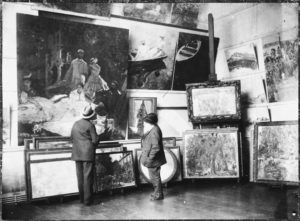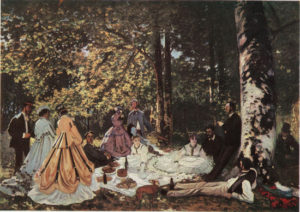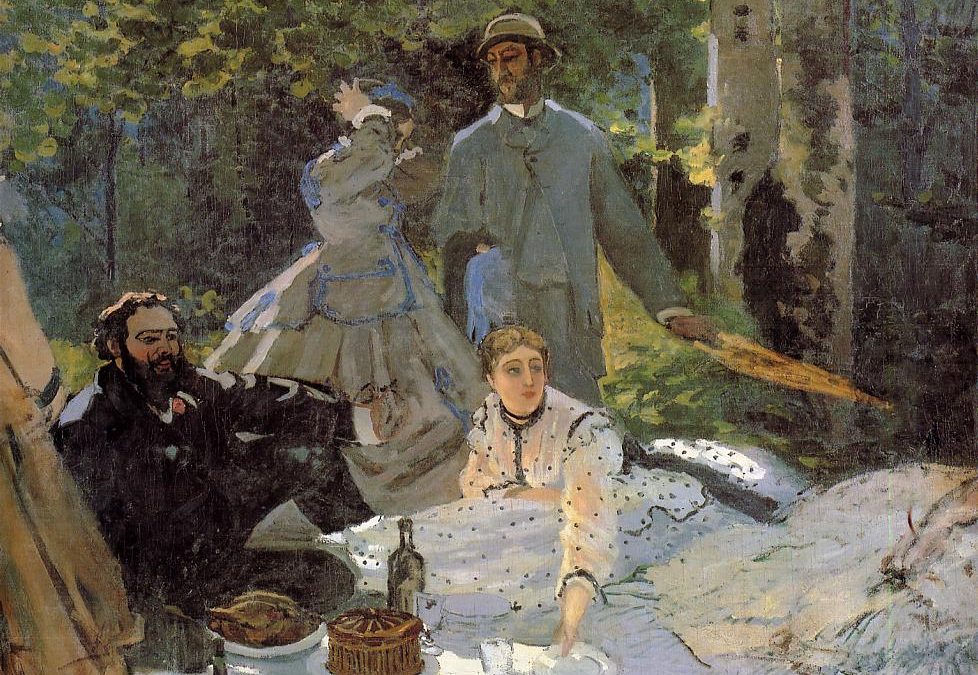Monet responded to Manet’s Le déjeuner sur l’herbe his painting in 1865 but left it uncompleted. Unlike Manet, who painted in the studio, Monet painted outdoors. This presented logistical problems because his picnic was to be monumental, approximately 15 x 20 feet. It was also intended to rival academic historical painting by depicting the well-to-do bourgeoisie society at play. It was a daunting task because Monet wanted to be au currant, and as fashion changed, he was plagued with revisions, which mattered to him, but no one else.

Claude Monet and the Duke of Treviso (1920)
Eventually, the incomplete painting was divided into panels. Only the oil sketch shows the complete work. Monet finally hung only the central portion at Giverny. Its central figure is Camille, who was not then his wife. She sits holding a plate and reaches forward as if to be served.
The luxury of the scene belies the fact that 1865 Monet, then twenty-five years old, was broke. It may be that Monet is also challenging the picnic scenes of Antoine Watteau or Auguste Barthélemy Glaize.
Lynne Taylor-Corbett’s Picnic on the Grass (2007) choreographed a dance portraying Claude Monet’s painting. The music is from Francis Poulenc’s Sinfonietta (1947).
The menu includes roasted chicken, terrine or casserole, bread, fruits, and wine.

Study for Luncheon on the Grass (1865). The Pushkin Museum of Fine Arts, Moscow
Monet and his family liked automobile racing, mushroom picking, game hunting, and picnicking. Dining alfresco appealed to them, and they did so often, especially after 1883, after settling at Giverny. Claire Joyes’ Monet’s Table (1989) explains that Monet was fastidious about freshness, insistent on quality, and adamant about dining elegantly in the country style. Family photographs show picnics on the Grass, while others show the family seated at tables in the field. Invariably, the cloth was white and set with dishes, flatware, and glasses. If there are servants, they are unobserved. According to Joyes, a typical picnic culled from Monet’s kitchen might provide stuffed eggs, pâté en croute, duck or beef pie, cold beef a la mode, bread, grapes, apples, cakes, chestnut or honey cookies, Genoa cake, fruit cake, champagne, or wine.
Featured Image: Central panel
See Claude Monet. Central Panel for Luncheon on the Grass (1865-1866), Musée d’Orsay, Paris; Study for Luncheon on the Grass (1865). The Pushkin Museum of Fine Arts, Moscow; Study for the left panel of the Luncheon on the Grass. National Gallery, Washington, D.C.; Claire Joyes. Monet’s Table: The Cooking Journals of Claude Monet. Photographs by Bernard Naudin. New York: Simon and Schuster, 1989.

